Nick Robinson's Blog, page 32
April 9, 2013
A base for data
I’ve started to catalogue the contents of my books. I’m quite the OCD obessive when it comes to catalogues and it’s surprising I didn’t do this years ago. Starting with partial data in Dennis Walker’s superb origamidatabase®, I’ve been adding and teaching myself how to do SQL queries in the process ;)
You can see the results here
The title of this post comes from a wonderful answer given to me once by a student when I asked “what is a database”?
April 1, 2013
Cut & Fold Techniques for Promotional Materials : Paul Jackson
 128 pages, Softback published by Laurence King ISBN 178067094X 22cm square(!)
128 pages, Softback published by Laurence King ISBN 178067094X 22cm square(!)
Following on from his previous titles in this series (“Folding Techniques for Designers: From Sheet to Form” and “Structural Packaging: Design Your Own Boxes and 3D Forms”), Paul continue to share the fruits of many years of experience and expertise in the field of cut/folded card/paper. Unlike books aimed at the craft market, this is not just a series of models, it is a collection of ideas for the reader to take and adapt and apply to suit their own ends.
It’s also an interesting reflection on where Paul sees himself at this stage in his life, since he is, in effect, giving away many of the secrets that made him such a successful professional in this field! Needless to say, simply owning these books won’t replicate the years of experience he has, but it will certainly offer a handy primer for many beginners.
Inside, you get chapters on “before you start”, flexagons, modular solids, envelopes, puzzles/illusions, folded booklets and novelties. Whilst there are plenty of things to fold in the book, it’s not aimed at folders. The chapter on modular solids is largely based on cut/folded shapes, although it’s fascinating to see extensions of Jackson’s own cube (an “inside out” version of the classic playing card cube) which use 2 or 3 pieces instead of 6 to create cubes. The envelopes are mostly pure origami, not that it’s important! The “chain of cubes” in the novelty section is most intriguing.
The design of the book is clean and uncluttered, reflecting the contents. I can’t help feeling that it looks slightly dated in today’s modern world of graphic flair, but this shouldn’t adversely influence buyers from an academic background. Colour is used fleetingly throughout – I would have gone the extra mile and included colour images for the final photo of each design – monochrome doesn’t really do them justice and they look a bit “70s” to my eyes.
The diagrams themselves are clear and should make following the projects easy, even for beginners. Somewhat unusually, Paul created the final artwork on computer using Freehand, (something I never thought I’d see ;) so we miss out on the lively feel of his usual hand-drawn artwork.
As you would expect, Paul has been scrupulous in his accreditation for ideas, a whole page at the end lists his sources and points out that it is getting harder to indicate provenance with complete reliability.
Should you buy this book? As a newcomer to folding/cutting, I think it’s about as essential a volume as you’re likely to find. If, like me, you’ve worked in the field yourself for a long time and have a large collection of Jackson books, I’d still recommend buying it. It’s a fabulous collection and will give you lots of ideas to develop yourself. I’m certain that these books will form “required reading” for anyone studying and working in packaging and design.
It can be bought online for £10.20 with free postage, but do try to support your local bookshop, even if it costs a pound or two more. Final note to the publishers – if you’re going to put stickers on the cover promoting other books, please ensure they peel off easily – this one didn’t ;(
March 31, 2013
Doris Lauinger RIP
 I can’t recall exactly when I first met Doris, but it would have undoubtedly been at an Origami Deutschland convention, probably in the late 90s. She was quite short and had close-cropped hair, which gave her quite an “elfin” appearance. It’s hard to quantify what it is that makes two people “get on”, but we did and over the years, a close (if necessarily remote) friendship developed. We exchanged emails frequently and I began to make diagrams for some of her designs.
I can’t recall exactly when I first met Doris, but it would have undoubtedly been at an Origami Deutschland convention, probably in the late 90s. She was quite short and had close-cropped hair, which gave her quite an “elfin” appearance. It’s hard to quantify what it is that makes two people “get on”, but we did and over the years, a close (if necessarily remote) friendship developed. We exchanged emails frequently and I began to make diagrams for some of her designs.
In the origami world, there are the superstar creative folders, who we are generally in awe of, and the vast majority who simply fold and take great pleasure from it. In between these two are a small group who are creative in a more modest way, adapting designs, spreading ideas, making beautiful displays and taking it one step beyond simply folding a model.
Doris was one of these – she followed her own creative muse in origami, generally in the areas of envelopes, wallets, stars and boxes. She took great delight in folding these designs using attractive paper that she found in her home town of Bonn, in Germany.
In 2007 my wife Ali and I were lucky enough to spend some time with Doris at her home. She furnished us with two bicycles from her garage so that we could explore along the banks of the Rhine. We learned that Doris had nursed her husband to the end of his terminal illness and lived alone since then. We joked about trying to find her a boyfriend – she admitted that she had a “thing” about tall Austrians, perhaps even Arnold Schwarzenegger!
 Doris had firm opinions and would happily discuss them – she certainly took no nonsense from Englishmen! This made her a very engaging companion – she gave Ali and I a tour of her home town and she pointed out all kinds of historical and architectural features.
Doris had firm opinions and would happily discuss them – she certainly took no nonsense from Englishmen! This made her a very engaging companion – she gave Ali and I a tour of her home town and she pointed out all kinds of historical and architectural features.
Sat round a table folding with Doris was a treat; she had a keen eye for creative options and always thought of the bigger picture, how the finished model would look, rather than obsessing about specific techniques. I published her “Christmas Greetings Card” in my book “World’s Best Origami” and she had several models in British Origami Model Collections, as well as her native “Origami Deutschland” magazine.
I had been exchanging emails about diagramming a design of hers only a few days before the end. This made her sudden death particularly shocking and painful – she had only just come through another long illness and said that she was feeling great.
We will miss her cheerful optimism and her inspired creative touch. Like her other friends, I feel honoured to have known her. I hope to produce a booklet displaying her creative work, if you have any Lauinger designs, please share them with me. Below is the design I was diagramming for her, a typically clever use of a bird base..
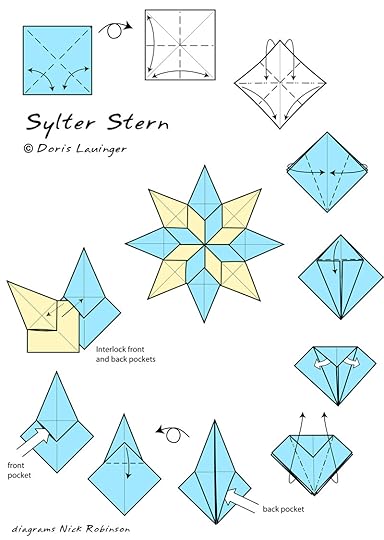
Sylter Stern by Doris Lauinger
March 29, 2013
I’m getting married in the morning!
Origami and politics are not often mentioned in the same breath, but there’s no reason why this should be – art and politics are closely intertwined. So, in support of the Human Rights Campaign’s push for marriage equality in America, I’ve come up with this simple design - 6 creases, 2 squashes ;)

March 25, 2013
Angelic Upstart
Have been sent a pdf of my book on origami angels to proof-read. Quite a bit of work required, as the layout bod didn’t quite follow the sequences properly, but touch wood, all will be well by the time it’s released! Here’s a snap from one of the chapter titles. The designs are mine other than the “heart with wings”, by the legendary Francis Ow, whose website I’m honoured to maintain.
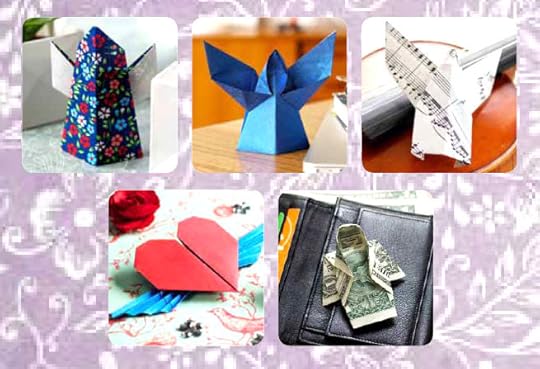
March 13, 2013
David Lister RIP
I have worked on this for several hours, but it may never say exactly what I want, or properly express my sorrow, so here it is, for what it’s worth.

David and Margaret Liuster, Grimsby 2012
I first met David Lister properly at my first council meeting, in the attic at Mick Guy’s house. I’d seen him at conventions, most particularly during the AGMs, which he ensured were run to the letter of the constitution. David didn’t get really involved with the day to day issues of the society (indeed, he nodded off from time to time!) but whenever a legal issue cropped up, he turned his full attention to the matter in hand and gave invaluable advice.
For several years, I thought of him as the “legal advisor who didn’t fold very often”. The only time most people heard him speak was during AGMs when he would delight in “taking the chairmans position whilst he stands down to be re-elected”. Everything needed to be above board for David! It was only later I began to appreciate how much work he did as a researcher / historian/archivist.

David Lister, Pauline Trew, David Brill at a BOS Council meeting
David was what I think of as a “quintessential Englishman”, he personified a time seemingly now long gone when gentlemen were polite, reserved and impeccably dressed. As a former lawyer, he possessed a sharp intellect and the ability to weigh up different interests and arrive at a considered conclusion.
His natural reserve made it difficult to get to know him well, he took life seriously, it seemed. However, we shared several train journeys to and from conventions, spoke at council meetings and slowly, I began to discover the warm, friendly and considerate personality that lay behind the quiet exterior.
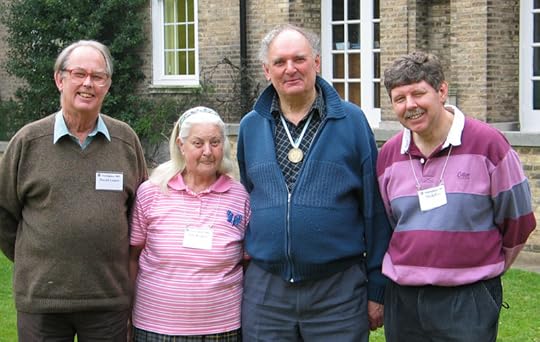
David Lister, Iris Walker, John Smith, Mick Guy
For several years we were both members of a small group known as “FOLD” who circulated a privately produced collection of origami material every two months. With other contributors including LaFosse, Lang, Sakoda, Temko and several others, I was in heaven every time the latest issue thudded through my letterbox. In it, David would knowledgeably expound on a particular subject, making for fascinating and authoritative reading. David, Florence and myself met once at a BOS convention, it was a happy event.
[image error]
David Lister, Florence Temko, Nick Robinson
Like any sensible historian, he would never make claims that he could not authenticate and was always eager to read responses to his propositions and amend them accordingly. (I have recently had permission from his family to extract and share the text from these pages via the BOS site.)
Like many people around the world, our relationship blossomed with the arrival of email. Despite professing few technical computer skills, David took to email like a duck to water and sent out countless long, considered and interesting emails to anyone who asked a simple question of him. He was seemingly unable to give concise answers to questions and I wonder where he found the time to do this. It seems David also kept a printed copy of every letter he sent or received, doubtless a habit he developed as a lawyer, so there are rich seams of origami gold that may yet emerge.
The BOS council nagged him relentlessly to produce some kind of book or booklet, but he felt that his knowledge was incomplete and that he lacked key information in order to write anything definitive.We never succeeded in this quest.

The Origami Bible
Some years ago I wrote a book called the “Origami Bible” and asked David if he could write an introductory chapter on the history of origami. I think I said something like “We have around 10,000 words to play with”. His reply was “Only 10,000? I can’t begin to give a meaningful summary in so few words.” Eventually, I persuaded him that the publishers would not devote more space to the chapter and frankly would rather have included a few more models and he relented. Having sent me the text, amendments came in regularly right up to the printing deadline. Sadly, this may be one of the few things that he wrote for a commercial printing.
[image error]
David Lister’s chapter in the “Origami Bible”
He willingly gave permission for me to start the “Lister List” and was amused that he shared the same name as a character from “Red Dwarf”. Since then, I have sought copies of anything he posted to build up what is an impressive archive. If you have material to share, please let me know.

Four drinking birds by David Lister
David professed to be “not creative”, but when I once remarked that it was unusual to have folded for so long and never have created a single design, he indignantly informed me that he had created “a single design”. It was a model called “4 thirsty birds”, which he taught to me and I later included in my “Origami For Dummies”. This was, however, his only creation!
As he became older, David began to try and make plans for his remarkable library. I was lucky enough to browse through the origami section this extraordinary collection – never have I seen the like! When questioned about the size of it (imagine 3 large rooms with wall to wall book shelves!) he shrugged and said “As soon as I could reasonably afford it, I bought a book a day and all these years later, this is what you get!”
Along with others, I tried to conceive of a way in which his collection could be properly managed. Follwoing a trip to Grimsby with Joan Sallas and Wayne Brown, we got as far as producing an electronic listing but sadly, the end came before any sensible plan had been agreed with David.

Joan Sallas, David Lister, Nick Robinson, Grimsby 2012
In truth, I suspect he was finding the idea of parting with his archives far harder than he could have imagined. I can only sympathise – it’s a situation we will all reach one day and there is no easy answer.
As well as losing a dear friend, the origami world has lost perhaps its leading historian and with him, untold amounts of knowledge and research. The work of cataloguing and assessing his collection and personal archives may well take years, but I hope at some point his studies will be available for the world to enjoy and for future historians to build upon.
I was talking recently with a friend about a small point of academic origami interest and we remarked that in normal circumstances, we would have asked David for advice, but what do we do without him to rely upon? No answer was forthcoming, but David was an eminently pragmatic man and would surely have told us to knuckle down and do the work ourselves.
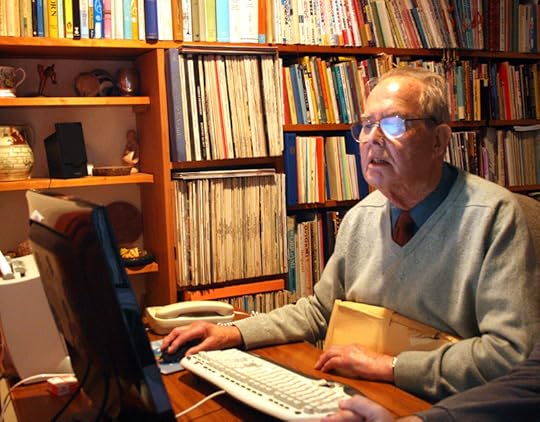
David Lister, surrounded by his library…
I have set up a page where people can leave written tributes to the man. It can be found here http://www.britishorigami.info/academic/lister/tribute.php
Nick Robinson
You may wish to read a some rare information about himself that David shared in from an email exchange with Lisa Corfman.
February 20, 2013
Low self-esteem? Try Origami!
I spend far too much of my life rummaging through charity shops and antiques centres. It’s really not good, because I don’t have the money to spend/waste the way I used to. There’s also the issue of bringing yet more junk home (as my children see it) when I don’t have enough room as it is.
Still, there it is, I was tempted and found a less than rare item in the book section, Harbins “Teach Yourself”. I always buy these (£1 seemed reasonable) in order to give away to beginners at demos and meetings. What caught my eye enough to warrant a photo was the company that this book kept. The books weren’t seemingly filed by category, but whilst origami is not usually to be found in “self-help”, it seems as good a way as any to cure low self-esteem ;)
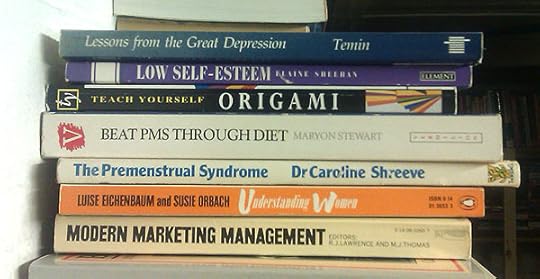
February 3, 2013
You’ve been framed – Star Dish
The wonderful David Wires pointed out to me today that there’s another video of my work on Youtub. I don’t object to this practise at all, but it would be so much nicer if people asked before making it and enquired as to what kind of credit I would like (mostly my name and web site address).
It’s not a bad video (although like many, seems to lack decent lighting). There seems to be no audio, so there’s a deal of finger pointing to explain location points when a few words would have really helped. Still, it’s good for the ego that they like the design enough to make a video of it. The diagrams for the design can be found on my diagrams page.
February 1, 2013
Just call me Angel of the morning…
 Reaching the end of my work on a book of origami angels – it’s been a trying time, since the publishers have insisted on approving (or rejecting!) every design. Many good models have failed to find favour. This is alright as it goes, but it gets harder each time to come up with something new. There are only so many designs out there that I feel are of the right quality, so I have to create from scratch.
Reaching the end of my work on a book of origami angels – it’s been a trying time, since the publishers have insisted on approving (or rejecting!) every design. Many good models have failed to find favour. This is alright as it goes, but it gets harder each time to come up with something new. There are only so many designs out there that I feel are of the right quality, so I have to create from scratch.
So, here is the final square based design and I’ve just completed a dollar-bill angel, photo to come soon. Books are always a creative challenge, but, you hope, not too much of a challenge, or the old gray matter begins to turn into jelly. The background of the photo is a sheet of white paper, which when badly lit seems to generate a pleasing “night time” effect – all deliberate, of course.
January 29, 2013
Pictures worth 1000 words?
I’m working on a promotional origami flyer on behalf of the BOS, but am having great difficulty selecting the best image for the front. So, I’d welcome your input – can you recommend one single image that sums up all we love about origami?



